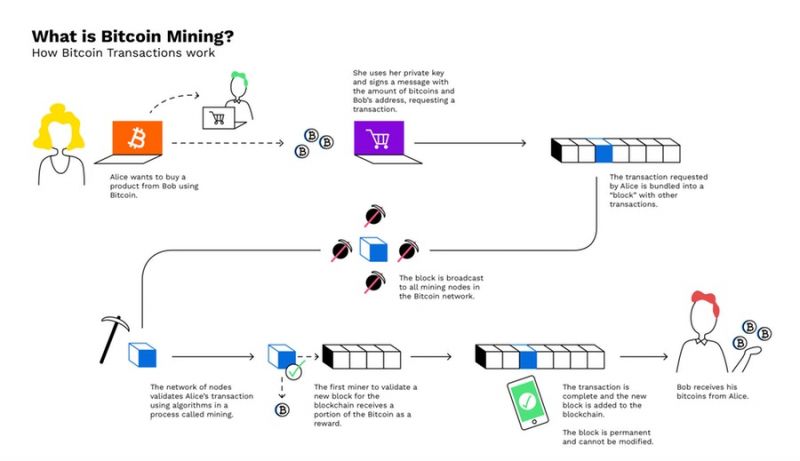Mining: Difference between revisions
Mr. MacKenty (talk | contribs) |
Mr. MacKenty (talk | contribs) No edit summary |
||
| Line 4: | Line 4: | ||
At its core, the term ‘Blockchain mining’ is used to describe the process of adding transaction records to a blockchain. This process of adding blocks to the blockchain is how transactions are processed and how money moves around securely on Bitcoins. This process of Blockchain mining is performed by a community of people around the world called ‘Blockchain miners.’<ref>https://intellipaat.com/blog/tutorial/blockchain-tutorial/what-is-bitcoin-mining/</ref> | At its core, the term ‘Blockchain mining’ is used to describe the process of adding transaction records to a blockchain. This process of adding blocks to the blockchain is how transactions are processed and how money moves around securely on Bitcoins. This process of Blockchain mining is performed by a community of people around the world called ‘Blockchain miners.’<ref>https://intellipaat.com/blog/tutorial/blockchain-tutorial/what-is-bitcoin-mining/</ref> | ||
New blocks are created when a sufficient number of mining nodes have verified a block of transactions. The miners are issued a reward in the cryptocurrency for each block mined, in doing so, more of the specific cryptocurrency is put into circulation. | |||
In bitcoin, every time 210,000 blocks are added to the blockchain, the mining reward is halved to ensure a steady supply of Bitcoin. Generally speaking, this happens every four years. | |||
At present, miners are rewarded with 12.5 Bitcoin for every block mined. At current hash rates the next reward halving is expected to happen in May next year. After which, miners will be rewarded with 6.25 Bitcoin per block. | |||
[[File:Bitpanda-Infographics 7-bitcoin-blockchain.jpeg|800px]] | [[File:Bitpanda-Infographics 7-bitcoin-blockchain.jpeg|800px]] | ||
Revision as of 19:56, 8 March 2020

A peer-to-peer computer process, Blockchain mining is used to secure and verify bitcoin transactions. Mining involves Blockchain miners who add bitcoin transaction data to Bitcoin’s global public ledger of past transactions. In the ledgers, blocks are secured by Blockchain miners and are connected to each other forming a chain.[2]
At its core, the term ‘Blockchain mining’ is used to describe the process of adding transaction records to a blockchain. This process of adding blocks to the blockchain is how transactions are processed and how money moves around securely on Bitcoins. This process of Blockchain mining is performed by a community of people around the world called ‘Blockchain miners.’[3]
New blocks are created when a sufficient number of mining nodes have verified a block of transactions. The miners are issued a reward in the cryptocurrency for each block mined, in doing so, more of the specific cryptocurrency is put into circulation.
In bitcoin, every time 210,000 blocks are added to the blockchain, the mining reward is halved to ensure a steady supply of Bitcoin. Generally speaking, this happens every four years.
At present, miners are rewarded with 12.5 Bitcoin for every block mined. At current hash rates the next reward halving is expected to happen in May next year. After which, miners will be rewarded with 6.25 Bitcoin per block.
Video[edit]

